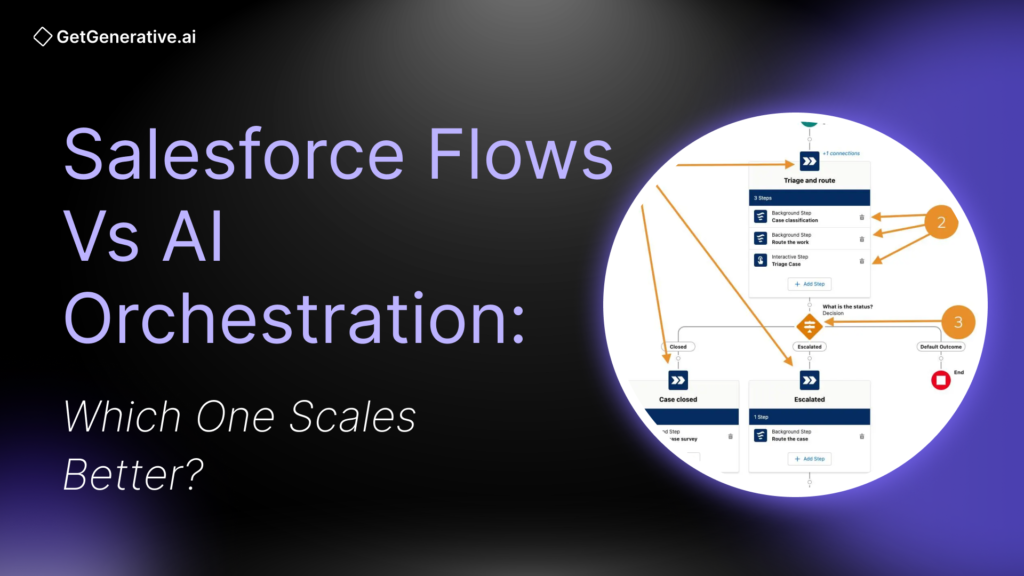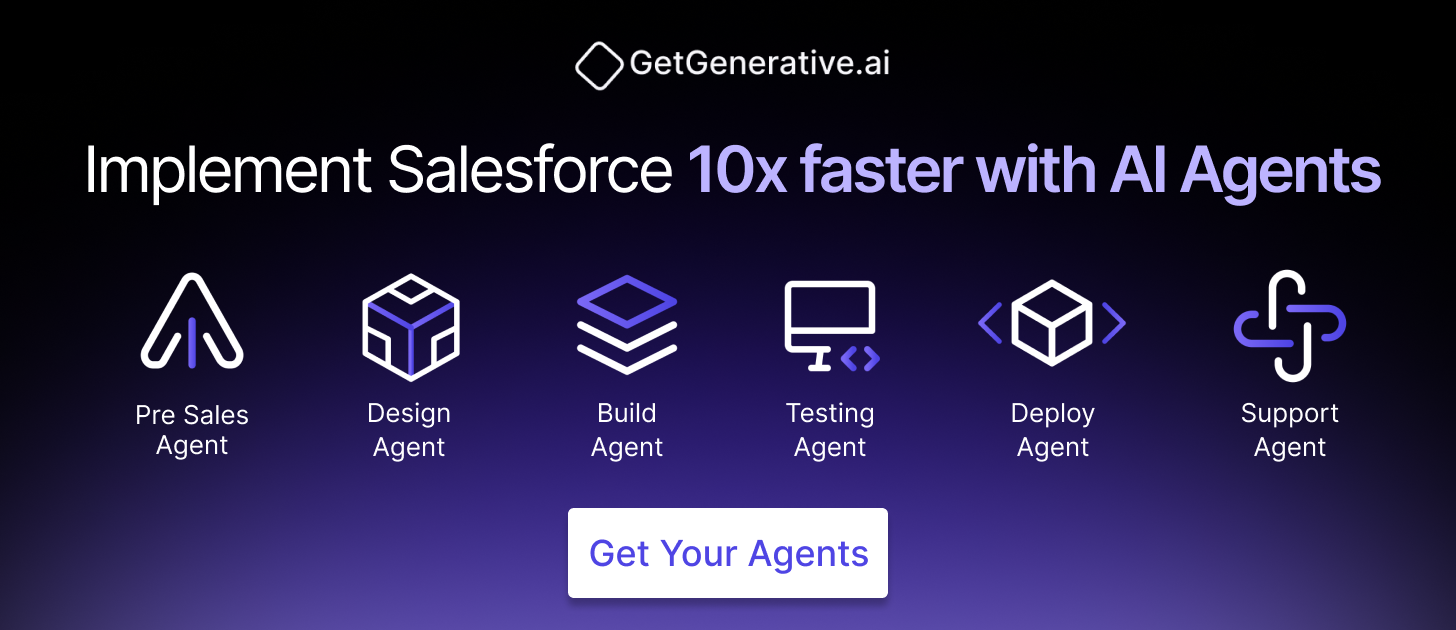Salesforce Flows vs AI Orchestration: Which One Scales Better?
According to MuleSoft, organizations now manage over 1,000 applications on average, yet only 29% of these are integrated, leaving massive automation gaps. Meanwhile, 91% of companies say automation is essential to “do more with less,” and 82% plan to deploy AI agents within three years.
These shifts highlight a pivotal decision for Salesforce-driven enterprises:
Should you rely on proven Flow-based automation—or embrace the flexibility and intelligence of AI orchestration to scale operations across silos and systems?
Salesforce is evolving from traditional automation to intelligent orchestration. Salesforce Flows and Flow Orchestration have been core to low-code process design, while the recent introduction of AI orchestration through Einstein GPT, Data Cloud, and Agentforce promises autonomous decision-making and next-generation agility.
In this blog, we’ll dissect both paradigms—Flow-based automation and AI orchestration—evaluating their architecture, scalability, governance, extensibility, and real-world applications. Let’s get started!
Salesforce Flows
Salesforce Flows are the cornerstone of low-code, declarative automation. Built to run natively on the Salesforce platform, they support rapid deployment of workflows for data manipulation, UI interaction, and logic execution across Salesforce objects, MuleSoft, Slack, Tableau, and more.
In March 2022 alone, Salesforce executed over 1.3 trillion automation runs, delivering an estimated $2.19 trillion in business value and saving 109 billion hours of work monthly.
Key Capabilities and Architecture
- Flow Types: Screen Flows (guided user interaction) and Auto-Launched Flows (triggered by records, schedules, or events).
- Triggers: Record changes, button clicks, platform events, REST APIs.
- Execution: Each Flow interview runs as a Salesforce transaction, governed by platform limits (e.g., 100 SOQL queries, 150 DML operations).
- Integration: Connects natively with Slack, MuleSoft, and legacy systems (via MuleSoft RPA).
- Governance: Managed as metadata; flows support change sets, debugging tools, and CI/CD pipelines.
Benefits of Salesforce Flows
Strength | Description |
Rapid Value | Empowers admins to deploy automations without code. |
Platform Integration | Deeply tied to Salesforce’s security model, Customer 360, and uptime guarantees. |
Extensibility | Supports API calls, Slack integration, and external data through Flow Integration. |
Enterprise Scale | Global brands like Vonage, RBC Wealth Management, and ENGIE automate key business processes with Flows. |
Unified Toolset | Consolidates legacy tools like Workflow Rules and Process Builder into one automation suite. |
Challenges and Limitations
Despite its strengths, Flow automation has constraints:
- Governor Limits: Flows are subject to transaction caps. Complex or bulk processes must be designed for scale (e.g., avoid SOQL in loops).
- Transactional Boundaries: One failed element can roll back the entire interview.
- Static Logic: Cannot dynamically adjust logic without explicit conditions.
- Maintenance Overhead: Complex flows require modular design, subflows, and robust documentation.
- Advanced Licensing: Features like Flow Orchestration or high-volume RPA usage incur additional costs (e.g., $1 per orchestrator run after 600 free executions/year).
Flow Orchestration
To handle multi-user, cross-functional processes, Salesforce introduced Flow Orchestration, now GA since Winter ’22. This tool allows admins to chain flows into stages and steps, assigning tasks to users or queues and controlling process flow with embedded logic.
Unlike standard flows (data-centric), flow orchestration is user-centric and designed around who does what and when.
Use Case Example: Claims Review in Insurance
- Stage 1: Auto-launched flow collects documentation.
- Stage 2: Screen flow assigns claim review to an analyst.
- Stage 3: Notification sent to supervisor upon review completion.
Each orchestration includes:
- Steps: Run Flows, assign screen tasks, send messages.
- Stages: Group steps, set exit criteria, insert decision branches.
- Monitoring Tools: Orchestration Work Guide lets admins view pending tasks and manually reroute stuck flows.
- Deployment and Licensing: Appears as separate metadata, follows same CI/CD path as Flows. Includes 600 runs/year; $1 per run after.
Where Flow Orchestration Excels
Advantage | Details |
Reuse Existing Flows | No need to rewrite logic—sequence and augment existing automations. |
Human Workflow Management | Assigns tasks to users/queues; tracks pending work. |
Enhanced Debugging | Monitors orchestration status beyond standard Flow logs. |
Logical Process Mapping | Makes it easier to represent and support full business processes (e.g., onboarding, escalations). |
Limitations
Flow Orchestration operates within Salesforce’s boundaries:
- Cannot invoke external systems independently.
- Cannot dynamically decide steps—requires pre-defined logic.
- Usage is cost-bound and may require budgeting for high-volume automations.
Still, Orchestration elevates Flows by providing process-level visibility, accountability, and structure across teams.
Also Read – Einstein GPT vs Custom AI Models: What Should You Choose?
AI Orchestration
Where Flows and Orchestration execute predefined rules, AI Orchestration uses generative AI and autonomous agents to make dynamic decisions in real time.
Salesforce’s AI automation suite includes:
- Einstein GPT & Copilot: Natural language-based prompt tools to generate flows, summarize data, and craft emails.
- Agentforce: Agentic AI platform enabling proactive, autonomous agents that act across Salesforce, Slack, and beyond.
- Einstein Trust Layer: Enterprise-grade AI governance with PII masking, zero-retention LLM calls, and audit trails.
- Data Cloud: Unified, real-time data layer powering AI insights.
“Even the most ambitious AI solutions can remain transparent and knowable to the people who create them.”
—Dr. Michela Paganini, Tech Lead Manager (TLM) at DeepMind
How AI Orchestration Works in Salesforce
Imagine automating a sales call summary:
- Agent 1: Summarizes transcript via LLM.
- Agent 2: Extracts action items and updates Salesforce records.
- Agent 3: Drafts follow-up email and notifies rep in Slack.
Behind the scenes, a planner (AI orchestrator) sequences these agents and passes context via Data Cloud. Einstein GPT interacts via prompts, and all data flows through the Trust Layer to maintain governance.
This shift enables Salesforce users to go from:
“Clicks, not code” → to → “Prompts, not clicks”
Architectural Differences: Salesforce Flows vs AI Orchestration
Attribute | Salesforce Flows & Orchestration | AI Orchestration (Einstein GPT, Agentforce) |
Execution | Runs on Salesforce’s native servers under multi-tenant architecture and strict governor limits. | Uses external AI services (LLMs, agents) coordinated by a planning engine; compute-intensive tasks offloaded to scalable AI models. |
Logic Design | Deterministic, flowchart-based, rules-driven. | Contextual, prompt-driven, generative, adaptive—able to choose next steps based on inputs. |
Data Handling | Native CRM data, respects field-level security, org-wide defaults. | Combines CRM + external data through Data Cloud; data flows through Einstein Trust Layer with PII masking and zero-retention guarantees. |
Latency | Millisecond response times (ideal for record-level operations). | Higher latency (seconds), depending on LLM API responsiveness. More suitable for reasoning-heavy tasks. |
Monitoring & Audit | Change sets, debug logs, and Flow test runs. | Full prompt logging, output review, AI confidence scores, and audit trails via Agentforce & Trust Layer. |
Interactivity | Structured UI via screen flows, decision elements, and forms. | Conversational UX via Copilot, SlackGPT, email bots, or custom UI embedded in Lightning pages or mobile apps. |
Scalability and Performance
Salesforce Flows: Proven Scale with Predictable Limits
- 1.3 trillion+ flow actions/month
- 44 billion+ actions/day
- Governed by limits: 50K records/query, 100 SOQLs, 2000 elements per flow
- Scales best with: modular subflows, bulkification, async triggers
Flows are extremely scalable within the Salesforce platform, particularly for predictable, repeatable business logic.
AI Orchestration
- Leverages scalable LLM infrastructure (cloud GPUs, multi-agent frameworks)
- Example: Salesforce’s Agentforce resolves 32,000+ support cases/week
- Can parallelize across agents, models, and data pipelines
- Requires orchestration runtime (e.g., Planner) to coordinate agent actions
AI orchestration has elastic potential, though real-world throughput will depend on governance, architecture, and use case fit.
Governance, Security, and Enterprise Trust
Salesforce Flows
- Integrated with Salesforce’s native security model
- Follows org-wide permissions, sharing rules, and audit capabilities
- Deployed via change sets or Salesforce DX
- Stable, mature governance practices
AI Orchestration
Salesforce introduces a robust Trust Layer to ensure responsible AI use:
- PII Masking: Sensitive data is replaced with tokens before LLMs see it
- Zero Retention: Third-party AI models cannot store prompts
- Audit Trails: All actions, prompts, and responses are logged
- Human Oversight: Agent suggestions can be reviewed or corrected by users
As Bernard Slowey, SVP at Salesforce, puts it:
“Humans [are] pivotal to success… AI augments, not replaces, their roles.”
Key governance additions: Prompt engineering guidelines, AI usage policies, cross-functional oversight teams.
Extensibility and Cross-Functional Integration
Salesforce Flows
- Works best within the Salesforce CRM ecosystem
- Can integrate external systems via Apex, MuleSoft, and Slack Flows
- Reusable subflows and AppExchange solutions available
AI Orchestration
- Agentforce 2dx supports embedding agents into Slack, Lightning, Mobile
- AI agents can invoke APIs, respond to events, and adapt logic across departments.
- Capable of interacting across Sales, Service, Marketing, HR, and Finance
Real-world example: An AI agent in Slack monitors a chat request, pulls context from Data Cloud, and updates legacy ERP via MuleSoft—all without user clicks.
Case Studies & Real-World Applications
1. Salesforce’s Own Agentforce Rollout
- 32,000+ weekly support interactions
- 83% resolution rate using AI agents
- Human agents retained for escalation
- Key takeaway: AI orchestration works at scale when layered with human review and transparent logs
2. Vonage + Flows
- Used Flows to streamline international order processing
- Automated expansion workflows, approvals, and notifications
- Resulted in faster time-to-market and improved internal collaboration
3. NTT Data + External AI Orchestration
- Used third-party hybrid orchestration to triage change requests
- Achieved 80% reduction in high-priority incidents
- Demonstrates how orchestrated AI agents can proactively prevent service failures
Conclusion
Salesforce automation is no longer just about low-code tools—it’s about intelligent orchestration at scale. Flows and Flow Orchestrator offer deterministic, governed, and highly reliable automation for structured processes. Meanwhile, AI orchestration opens the door to adaptive, conversational, and generative experiences, enhancing productivity beyond rules-based logic.
Curious how others are blending Flows and AI agents effectively?
GetGenerative.ai gives you a clear, structured workspace where proposals, scope plans, and automation design come together, powered by agents that stay aligned from pre-sales to go-live.
Take a look at how it works — Book a demo today!




